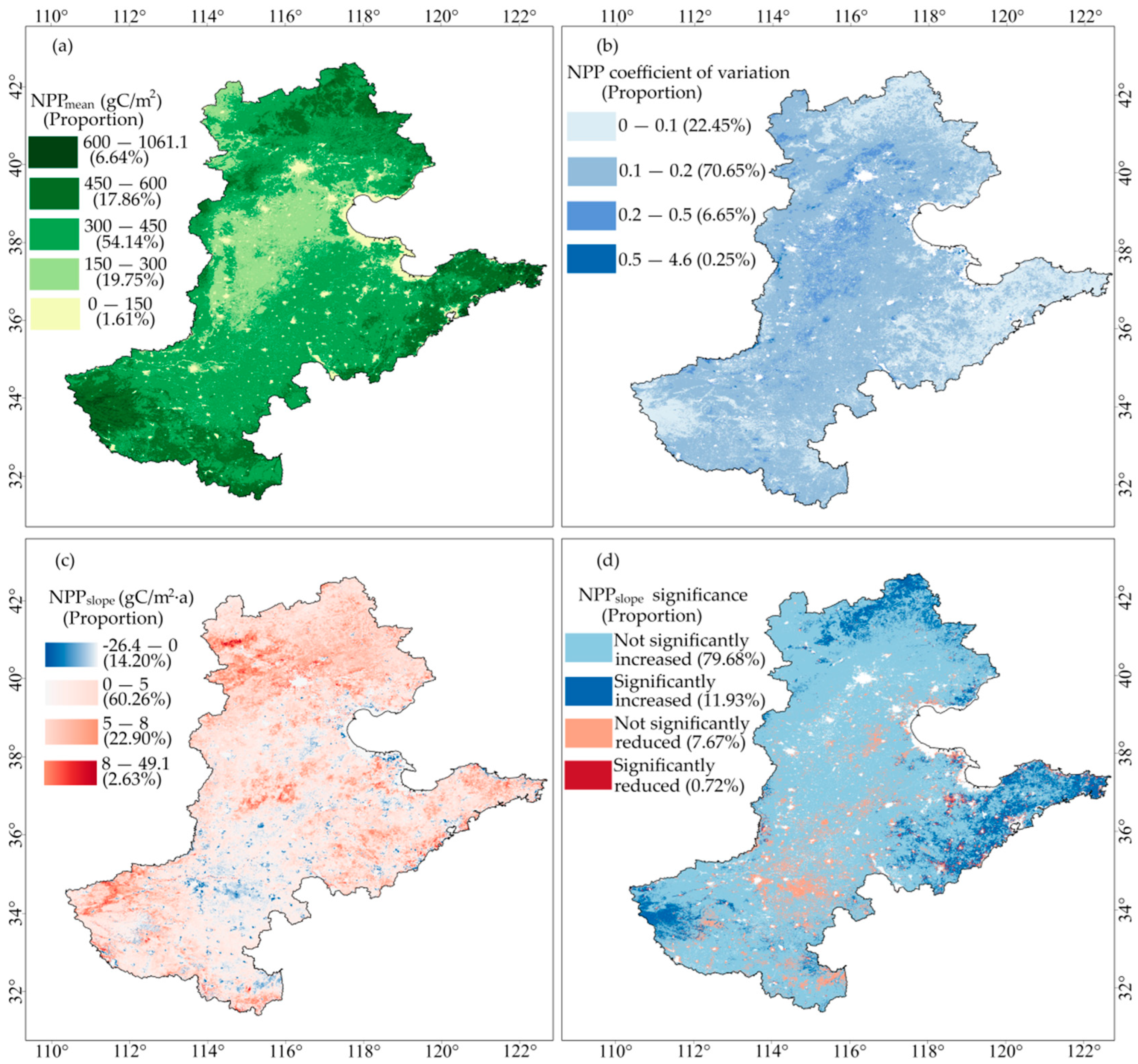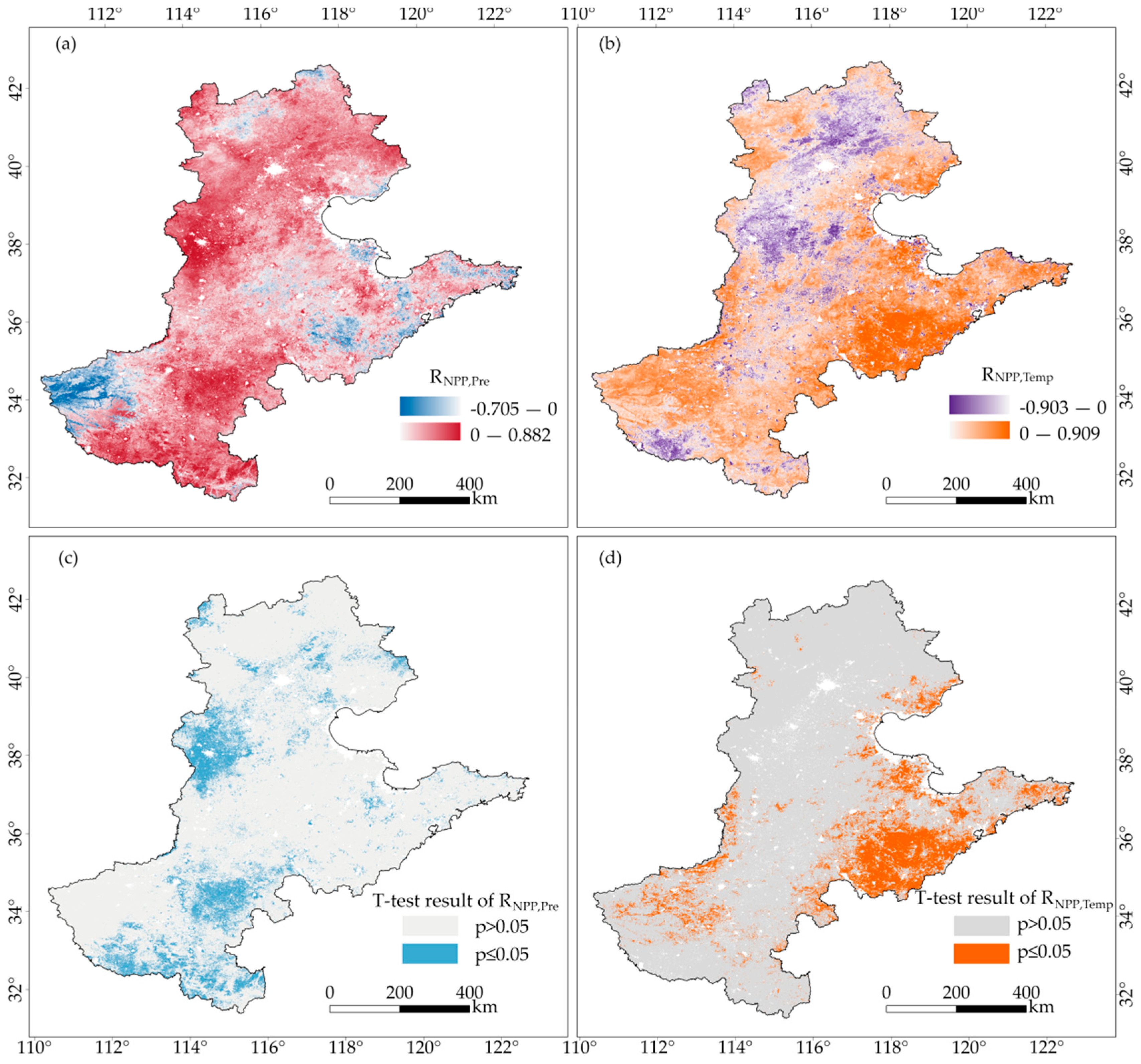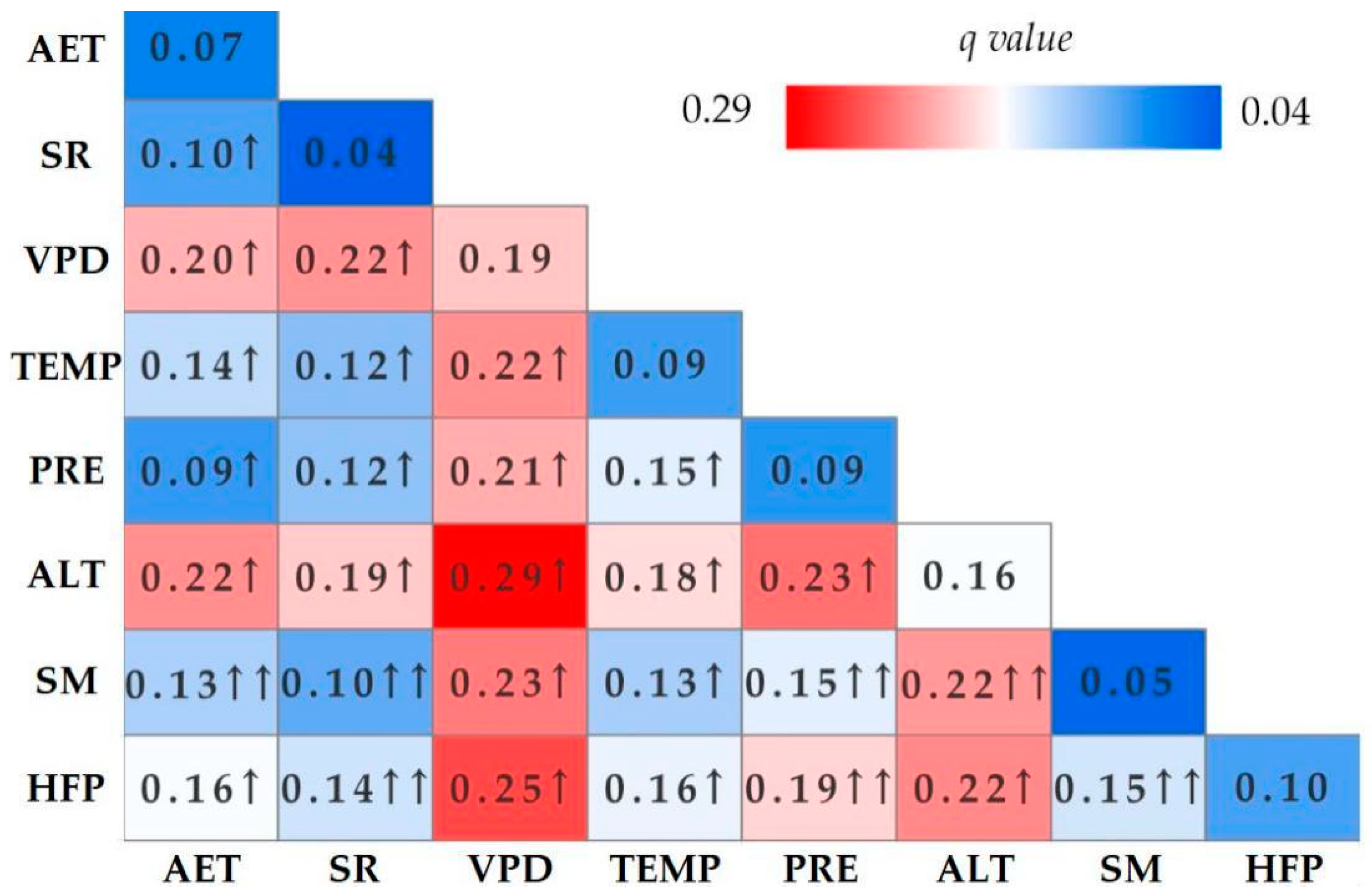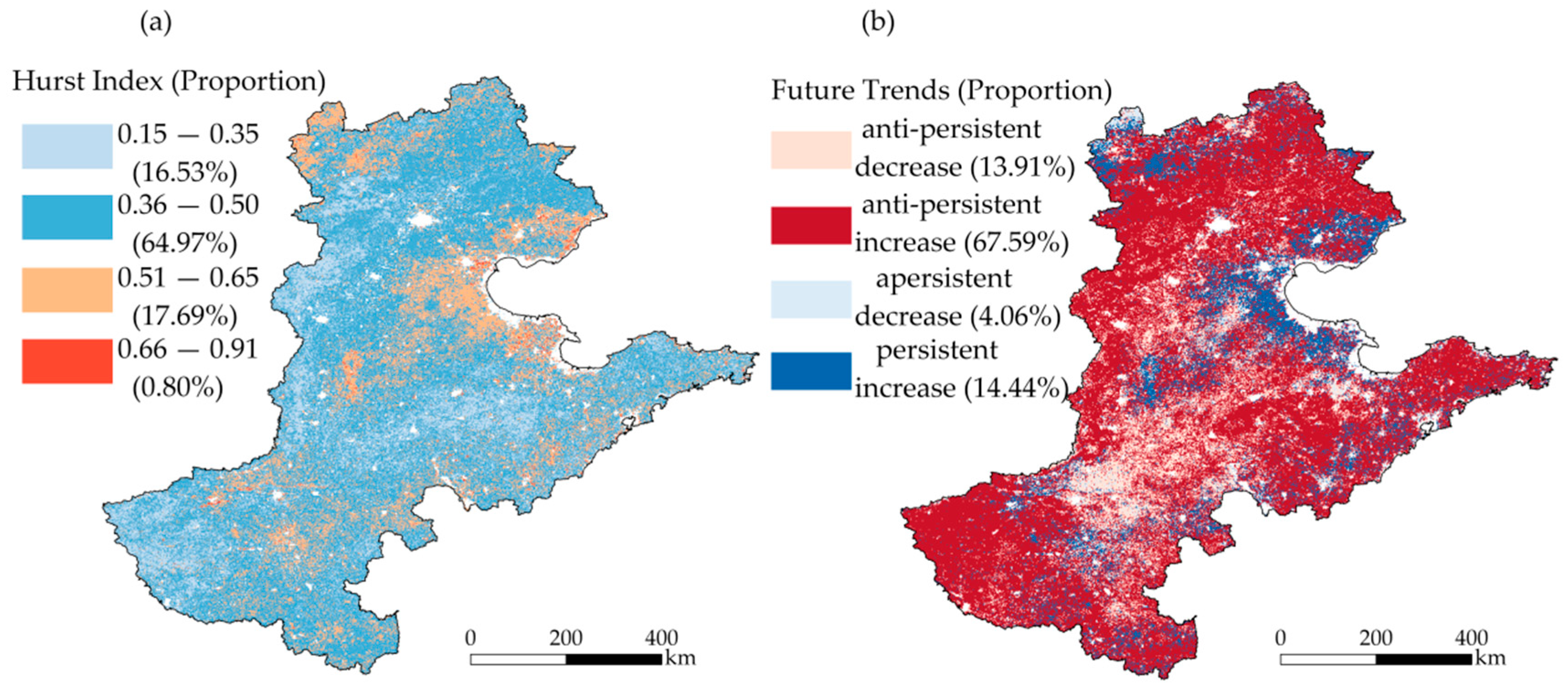Analysis of Spatiotemporal Variation and Driving Forces of Vegetation Net Primary Productivity in the North China Plain over the Past Two Decades
Abstract
1. Introduction
2. Materials and Methods
2.1. Overview of the Study Area
2.2. Data Sources
2.2.1. Vegetation Data
2.2.2. Environmental Factor Data
2.2.3. Land Use Data
2.2.4. Human Footprint Data
2.3. Methods
2.3.1. Trend Analysis
2.3.2. Correlation Analysis
2.3.3. Stability Analysis
2.3.4. Geographical Detector Model
2.3.5. Hurst Index for Trend Prediction
2.3.6. Workflow Diagram
3. Results
3.1. Spatiotemporal Distribution Patterns of NPP in the NCP
3.1.1. Temporal Variation in Vegetation NPP
3.1.2. Spatial Variation Characteristics of Vegetation NPP
3.2. Driving Factors of Vegetation NPP Change in the NCP
3.2.1. Climate Factors Influencing Vegetation NPP
3.2.2. Analysis of Vegetation NPP Drivers
3.3. Vegetation NPP Trends in the NPP
3.3.1. NPP Trends from 2003 to 2023
3.3.2. Prediction of Vegetation NPP Trends
4. Discussion
5. Conclusions
- (1)
- Between 2003 and 2023, the annual average vegetation NPP in the NCP showed a fluctuating upward trend, increasing by an average of 2.60 g C/m2 per year, with values ranging from 317.14 to 407.51 g C/m2 and a multi-year average of 360.33 g C/m2. The lowest annual average NPP occurred in 2007, while the highest was in 2021. Over the past two decades, the growth rates of NPP for cropland and broad-leaved forest vegetation have been significantly higher than those for other vegetation types (p < 0.05). Spatially, a general pattern of higher values in the south and lower values in the north was observed. This spatial disparity highlights the need for region-specific policies, such as precision agriculture in high-NPP zones and ecological restoration in low-NPP urban clusters to optimize vegetation carbon sequestration potential.
- (2)
- Significant spatial heterogeneity was observed in the relationships between temperature, precipitation, and vegetation NPP in the region. Saturated vapor pressure (VPD), altitude (ALT), and human activity intensity (HFP) were found to be the primary factors influencing vegetation NPP in the NCP. Their combined interaction had the strongest explanatory power, with VPD, ALT, and HFP accounting for 29%, 25%, and 25%, respectively. When human activities interact with other factors, their impact on NPP is significantly enhanced. To address the complexity of these interactions, future studies should integrate multi-agent modeling frameworks (e.g., structural equation modeling) to better quantify direct and indirect effects of multiple drivers.
- (3)
- From 2003 to 2023, the Hurst index in the NCP ranged from 0.15 to 0.91, with an average of 0.43. Regions with a Hurst index less than 0.5 accounted for 81.50%, while those with an index greater than 0.5 accounted for 18.50%. This indicates that the trend in vegetation NPP has strong anti-persistence, with 67.59% of regional NPP changes predicted to show anti-persistent increases, indicating uncertainty regarding future vegetation NPP changes. Future adaptive management strategies (e.g., real-time ecosystem monitoring and threshold-based resource management) must be prioritized to mitigate risks posed by non-linear ecosystem dynamics.
Author Contributions
Funding
Data Availability Statement
Acknowledgments
Conflicts of Interest
References
- Sims, D.; Luo, H.; Hastings, S.; Oechel, W.; Rahman, A.; Gamon, J. Parallel adjustments in vegetation greenness and ecosystem CO2 exchange in response to drought in a Southern California chaparral ecosystem. Remote Sens. Environ. 2006, 103, 289–303. [Google Scholar] [CrossRef]
- Manvailer, V.; Hamann, A. Validation of global precipitation time series products against tree ring records and remotely sensed vegetation greenness. PLoS ONE 2024, 19, e0299111. [Google Scholar] [CrossRef]
- Roxburgh, S.; Berry, S.; Buckley, T.; Barnes, B.; Roderick, M. What is NPP? Inconsistent accounting of respiratory fluxes in the definition of net primary production. Funct. Ecol. 2010, 19, 378–382. [Google Scholar] [CrossRef]
- Brian, W.; Leanne, M.; Xia, X.; Forest, I.; Wayne, H. Biodiversity: Net primary productivity relationships are eliminated by invasive species dominance. Ecol. Lett. 2023, 27, e14342. [Google Scholar]
- Crabtree, R.; Potter, C.; Mullen, R.; Sheldon, J.; Huang, S.; Harmsen, J.; Jean, C. A modeling and spatio-temporal analysis framework for monitoring environmental change using NPP as an ecosystem indicator. Remote Sens. Environ. 2009, 113, 1486–1496. [Google Scholar] [CrossRef]
- Afzali, A.; Hadian, F.; Sabri, S.; Leila, Y. Investigating net primary production in climate regions of Khuzestan Province, Iran using CASA model. Int. J. Biometeorol. 2024, 68, 1357–1370. [Google Scholar] [CrossRef]
- Nobre, C.; Sampaio, G.; Borma, L.; Castilla-Rubio, J.; Silva, J.; Cardoso, M. Land-use and climate change risks in the Amazon and the need of a novel sustainable development paradigm. Proc. Natl. Acad. Sci. USA 2016, 113, 10759–10768. [Google Scholar] [CrossRef] [PubMed]
- Alexander, J.; McCafferty, M.; Fricker, G.; Jeremy, J. Climate seasonality and extremes influence net primary productivity across California’s grasslands, shrublands, and woodlands. Environ. Res. Lett. 2023, 18, 064021. [Google Scholar] [CrossRef]
- Ma, Z.; Wu, J.; Yang, H.; Hong, Z.; Yang, J.; Gao, L. Assessment of vegetation net primary productivity variation and influencing factors in the Beijing-Tianjin-Hebei Region. J. Environ. Manag. 2024, 365, 121490. [Google Scholar] [CrossRef]
- Richter, G.; Topp, C. Climate factors contribute to grassland net primary productivity. Agronomy 2021, 11, 1076. [Google Scholar] [CrossRef]
- Bejagam, V.; Sharma, A. Impact of climatic changes and anthropogenic activities on ecosystem net primary productivity in India during 2001–2019. Ecol. Inf. 2022, 70, 101732. [Google Scholar] [CrossRef]
- Pessarrodona, A.; Filbee-Dexter, K.; Krumhansl, K.A.; Pedersen, M.F.; Moore, P.J.; Wernberg, T. A global dataset of seaweed net primary productivity. Sci. Data 2022, 9, 484. [Google Scholar] [CrossRef] [PubMed]
- Mohamedelhassan, A.; Zhang, B.; Jahelnabi, A.; Elhassan, E. Responses of annual variability of vegetation NPP to climate variables using satellite techniques in Gadarif State, Sudan. J. Geogr. Inf. Syst. 2024, 16, 136–147. [Google Scholar] [CrossRef]
- Naeem, S.; Zhang, Y.; Tian, J.; Qamer, F.; Latif, A.; Paul, P. Quantifying the impacts of anthropogenic activities and climate variations on vegetation productivity changes in China from 1985 to 2015. Remote Sens. 2020, 12, 1113. [Google Scholar] [CrossRef]
- Ugbaje, S.; Odeh, I.; Bishop, T.; Li, J. Assessing the spatio-temporal variability of vegetation productivity in Africa: Quantifying the relative roles of climate variability and human activities. Int. J. Digit. Earth. 2017, 10, 879–900. [Google Scholar] [CrossRef]
- Igboeli, E.; Ogbue, C.; Ochege, F.; Onyekwelu, A.; Qing, L.; Ajaero, C.; Hamdi, R.; Rahman, M.; Kayiranga, A.; Luo, G. Combined impacts of land change and climate variability on ecosystem net primary productivity in Arid Regions. Glob. Planet. Chang. 2025, 245, 104682. [Google Scholar] [CrossRef]
- Zhang, M.; Yuan, N.; Lin, H.; Liu, Y.; Zhang, H. Quantitative estimation of the factors impacting spatiotemporal variation inNPP in the Dongting Lake Wetlands using landsat time series data for the last two decades. Ecol. Indic. 2022, 135, 108544. [Google Scholar] [CrossRef]
- Liu, Y.; Wang, Q.; Zhang, Z.; Tong, L.; Wang, Z.; Li, J. Grassland dynamics in responses to climate variation and human activities in China from 2000 to 2013. Sci. Total Environ. 2019, 690, 27–39. [Google Scholar] [CrossRef]
- Field, C.; Behrenfeld, M.; Randerson, J.; Falkowski, P. Primary production of the biosphere: Integrating terrestrial and oceanic components. Science 1998, 281, 237–240. [Google Scholar] [CrossRef]
- Wang, X.L.; He, W.X.; Huang, Y.L.; Wu, X.; Zhang, X.; Zhang, B. Exploring spatial non-stationarity and scale effects of natural and anthropogenic factors on net primary productivity of vegetation in the Yellow River Basin. Remote Sens. 2024, 16, 3156. [Google Scholar] [CrossRef]
- Xue, H.; Chen, Y.; Dong, G.; Li, J. Quantitative analysis of spatiotemporal changes and driving forces of vegetation net primary productivity (NPP) in the Qimeng Region of Inner Mongolia. Ecol. Indic. 2023, 154, 110610. [Google Scholar] [CrossRef]
- Long, X.; Han, Y.; Wang, Q.; Li, X.; Feng, T.; Wang, Y.; Zhang, S.; Han, Y.; Li, G.; Tie, J.; et al. Adverse effects of ozone pollution on net primary productivity in the North China Plain. Geophys. Res. Lett. 2024, 51, e2023GL105209. [Google Scholar] [CrossRef]
- Ge, W.Y.; Deng, L.Q.; Wang, F.; Han, J. Quantifying the contributions of human activities and climate change to vegetation net primary productivity dynamics in China from 2001 to 2016. Sci. Total Environ. 2021, 773, 145648. [Google Scholar] [CrossRef]
- Tang, C.; Hal, O.; Hou, Y.; Simon, J.; Pierre, J. Assessing nitrogen circularity in food systems in the North China Plain. Resour. Conserv. Recycl. 2025, 213, 108015. [Google Scholar] [CrossRef]
- Peng, Q.; Wang, R.G.; Jiang, Y.; Li, C. Contributions of climate change and human activities to vegetation dynamics in Qilian Mountain National Park, Northwest China. Glob. Ecol. Conserv. 2021, 32, e01947. [Google Scholar] [CrossRef]
- Ba, W.; Qiu, H.; Cao, Y.; Gong, A. Spatiotemporal characteristics prediction and driving factors analysis of npp in Shanxi Province covering the period 2001–2020. Remote Sens. 2023, 15, 12070. [Google Scholar] [CrossRef]
- Zhao, Y.X.; Qie, X. Quantitative assessment of the relative impacts of climate change and human activities on net primary productivity of vegetation in the Beijing-Tianjin-Hebei Region. Front. Environ. Sci. 2024, 12, 1508433. [Google Scholar] [CrossRef]
- Li, F.; Zhang, K.; Ren, J.; Yin, C.; Zhang, Y.; Nie, J. Driving mechanism for farmers to adopt improved agricultural systems in China: The case of rice-green manure crops rotation system. Agric. Syst. 2021, 192, 103202. [Google Scholar] [CrossRef]
- Yang, G.; Li, S.; Wang, H.; Wang, L. Study on agricultural cultivation development layout based on the matching characteristic of water and land resources in North China Plain. Agric. Water Manag. 2022, 259, 107272. [Google Scholar] [CrossRef]
- Zhao, N.; Yue, T.; Li, H.; Zhang, L.; Yin, X.; Liu, Y. Spatio-temporal changes in precipitation over Beijing-Tianjin-Hebei Region, China. Atmos. Res. 2017, 202, 156–168. [Google Scholar] [CrossRef]
- Deng, X.; Xu, X.; Cai, H.; Li, J. Assessment the impact of urban expansion on cropland net primary productivity in Northeast China. Ecol. Indic. 2024, 159, 111698. [Google Scholar] [CrossRef]
- National Bureau of Statistics of China (NBS). China Statistical Yearbook 2024; Chapter 3; China Statistics Press: Beijing, China, 2024. [Google Scholar]
- Zeng, L.; Yang, L.; Su, L.; Hu, H.; Feng, C. The impact of policies on land use and land cover changes in the Beijing-Tianjin-Hebei Region in China. Environ. Impact Assess. Rev. 2025, 110, 107676. [Google Scholar] [CrossRef]
- Zhong, Q.; Ma, J.; Zhao, B.; Wang, X.; Zong, J.; Xiao, X. Assessing spatial-temporal dynamics of urban expansion, vegetation greenness and photosynthesis in Megacity Shanghai, China during 2000–2016. Remote Sens. Environ. 2019, 233, 111374. [Google Scholar] [CrossRef]
- Li, Y.; Wang, R.; Chen, Z.; Xiong, Y.; Huang, Q.; Huang, G. Increasing net ecosystem carbon budget and mitigating global warming potential with improved irrigation and nitrogen fertilization management of a spring wheat farmland system in Arid Northwest China. Plant Soil. 2023, 489, 193–209. [Google Scholar] [CrossRef]
- Wang, C.; Liu, D.; Bai, E. Decreasing soil microbial diversity is associated with decreasing microbial biomass under nitrogen addition. Soil Biol. Biochem. 2018, 120, 126–133. [Google Scholar] [CrossRef]
- Yu, X.; Zhu, Y.; Wang, B.; Liu, D.; Bai, H.; Jin, L.; Wang, B.; Ruan, H.; Mao, L.; Jin, F.; et al. Effects of nitrogen addition on rhizospheric soil microbial communities of poplar plantations at different ages. For. Ecol. Manag. 2021, 494, 119328. [Google Scholar] [CrossRef]
- Michaletz, S.; Cheng, D.; Kerkhoff, A.; Enquist, B. Convergence of terrestrial plant production across global climate gradients. Nature 2014, 512, 39–43. [Google Scholar] [CrossRef]
- Grešlová, P.; Laštovička, J.; Štych, P.; Kabrda, J. Land cover flows and land use intensity in the three decades of the post-communist Czechia: Changing trends and driving forces. Anthropocene 2023, 43, 100395. [Google Scholar] [CrossRef]
- Buitenwerf, R.; Sandel, B.; Normand, S.; Mimet, A.; Svenning, J. Land surface greening suggests vigorous woody regrowth throughout European semi-natural vegetation. Glob. Chang. Biol. 2018, 24, 5789–5801. [Google Scholar] [CrossRef]
- Bogale, T.; Degefa, S.; Dalle, G.; Abebe, G. Spatiotemporal dynamics of vegetation net primary productivity and its response to climate variability. Environ. Syst. Res. 2024, 13, 47. [Google Scholar] [CrossRef]
- Shirke, P.; Pathre, U. Influence of leaf-to-air vapour pressure deficit (vpd) on the biochemistry and physiology of photosynthesis in Prosopis Juliflora. J. Exp. Bot. 2004, 55, 2111–2120. [Google Scholar] [CrossRef] [PubMed]
- Burgess, A.; Ugalde, J. SOS: Speed of stomata opening and closing is influenced by vapour pressure deficit. Plant Physiol. 2024, 195, 251–253. [Google Scholar] [CrossRef] [PubMed]
- Ni, X.; Guo, W.; Li, X.; Li, S. Heterogeneity of increases in net primary production under intensified human activity and climate variability on the Loess Plateau of China. Remote Sens. 2022, 14, 4706. [Google Scholar] [CrossRef]
- Xu, Y.; Lu, Y.G.; Zou, B.; Xu, M.; Feng, Y. Unraveling the enigma of npp variation in Chinese Vegetation Ecosystems: The interplay of climate change and land use change. Sci. Total Environ. 2023, 912, 169023. [Google Scholar] [CrossRef]
- Teng, M.; Zeng, L.; Hu, W.; Wang, P.; Yan, Z.; He, W.; Zhang, Y.; Huang, Z.; Xiao, W. The impacts of climate changes and human activities on net primary productivity vary across an ecotone zone in Northwest China. Sci. Total Environ. 2020, 714, 136691. [Google Scholar] [CrossRef] [PubMed]
- Feng, Z.; Wang, L.; Peng, Q.; Li, J.; Liang, T. Effect of environmental factors on soil properties under different land use types in a Typical Basin of the North China Plain. J. Clean. Prod. 2022, 344, 131084. [Google Scholar] [CrossRef]
- Han, H.; Bai, J.; Ma, G.; Yan, J.; Wang, X.; Ta, Z.; Wang, P. Seasonal responses of net primary productivity of vegetation to phenological dynamics in the Loess Plateau, China. Chin. Geogr. Sci. 2022, 32, 340–357. [Google Scholar] [CrossRef]
- Li, W.; Zhou, J.; Xu, Z.; Liang, Y.; Shi, J.; Zhao, X. Climate impact greater on vegetation npp but human enhance benefits after the grain for green program in Loess Plateau. Ecol. Indic. 2023, 157, 111201. [Google Scholar] [CrossRef]
- Li, B.; Ding, J.; Liu, X. Returning farmland to forests and grasslands promotes soil quality restoration in Northeast China: Evidence from soil nitrogen cycle. Appl. Soil Ecol. 2024, 203, 105655. [Google Scholar] [CrossRef]
- Shi, S.; Zhu, L.; Luo, Z.; Qiu, H. Quantitative Analysis of the Contributions of Climatic and Anthropogenic Factors to the Variation in Net Primary Productivity, China. Remote Sens. 2023, 15, 789. [Google Scholar] [CrossRef]
- Ren, P. Spatio-temporal changes and driving mechanisms of vegetation net primary productivity in Xinjiang, China from 2001 to 2022. Land 2024, 13, 1305. [Google Scholar] [CrossRef]
- Mu, W.; Zhu, X.; Ma, W.; Han, Y.; Huang, H.; Huang, X. Impact assessment of urbanization on vegetation net primary productivity: A case study of the core development area in Central Plains Urban Agglomeration, China. Environ. Res. 2023, 229, 115995. [Google Scholar] [CrossRef] [PubMed]








| Data | Time | Resolution | Source |
|---|---|---|---|
| MODIS 17A3HGF(NPP) | 2003–2023 | 500 m | https://ladsweb.modaps.eosdis.nasa.gov/ (accessed on 26 December 2024) |
| Vegetation type | 1990–2000 | 1000 m | https://www.resdc.cn/ (accessed on 26 December 2024) |
| Annual average temperature and annual precipitation | 2003–2023 | 4400 m | https://climate.northwestknowledge.net/ (accessed on 26 December 2024) |
| Actual evapotranspiration | 2003–2023 | 500 m | https://www.resdc.cn/ (accessed on 26 December 2024) |
| Solar radiation | 2003–2023 | 500 m | https://www.resdc.cn/ (accessed on 26 December 2024) |
| Vapor pressure deficit | 2003–2023 | 500 m | https://www.resdc.cn/ (accessed on 26 December 2024) |
| Soil moisture | 2003–2023 | 500 m | https://www.resdc.cn/ (accessed on 26 December 2024) |
| Altitude | — | 90 m | https://earthexplorer.Usgs.gov/ (accessed on 26 December 2024) |
| Land use | 2023 | 30 m | https://zenodo.org/records/12779975 (accessed on 26 December 2024) |
| Human footprint | 2003–2022 | 500 m | https://figshare.com/ (accessed on 26 December 2024) |
| Impact Factor | AET | SR | VPD | TEMP | PRE | ALT | SM | HFP |
|---|---|---|---|---|---|---|---|---|
| q value | 0.07 | 0.04 | 0.19 | 0.09 | 0.09 | 0.16 | 0.05 | 0.10 |
Disclaimer/Publisher’s Note: The statements, opinions and data contained in all publications are solely those of the individual author(s) and contributor(s) and not of MDPI and/or the editor(s). MDPI and/or the editor(s) disclaim responsibility for any injury to people or property resulting from any ideas, methods, instructions or products referred to in the content. |
© 2025 by the authors. Licensee MDPI, Basel, Switzerland. This article is an open access article distributed under the terms and conditions of the Creative Commons Attribution (CC BY) license (https://creativecommons.org/licenses/by/4.0/).
Share and Cite
Yi, M.; Zhang, D.; An, Z.; Li, K.; Shang, L.; Sui, K. Analysis of Spatiotemporal Variation and Driving Forces of Vegetation Net Primary Productivity in the North China Plain over the Past Two Decades. Agronomy 2025, 15, 975. https://doi.org/10.3390/agronomy15040975
Yi M, Zhang D, An Z, Li K, Shang L, Sui K. Analysis of Spatiotemporal Variation and Driving Forces of Vegetation Net Primary Productivity in the North China Plain over the Past Two Decades. Agronomy. 2025; 15(4):975. https://doi.org/10.3390/agronomy15040975
Chicago/Turabian StyleYi, Mingxuan, Dongming Zhang, Zhiyuan An, Kuan Li, Liwen Shang, and Kelin Sui. 2025. "Analysis of Spatiotemporal Variation and Driving Forces of Vegetation Net Primary Productivity in the North China Plain over the Past Two Decades" Agronomy 15, no. 4: 975. https://doi.org/10.3390/agronomy15040975
APA StyleYi, M., Zhang, D., An, Z., Li, K., Shang, L., & Sui, K. (2025). Analysis of Spatiotemporal Variation and Driving Forces of Vegetation Net Primary Productivity in the North China Plain over the Past Two Decades. Agronomy, 15(4), 975. https://doi.org/10.3390/agronomy15040975




